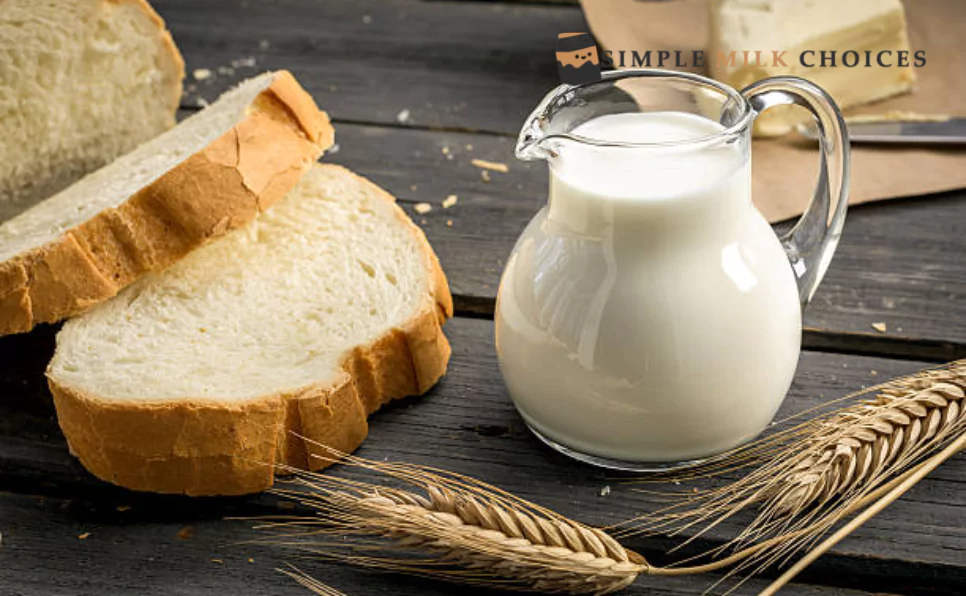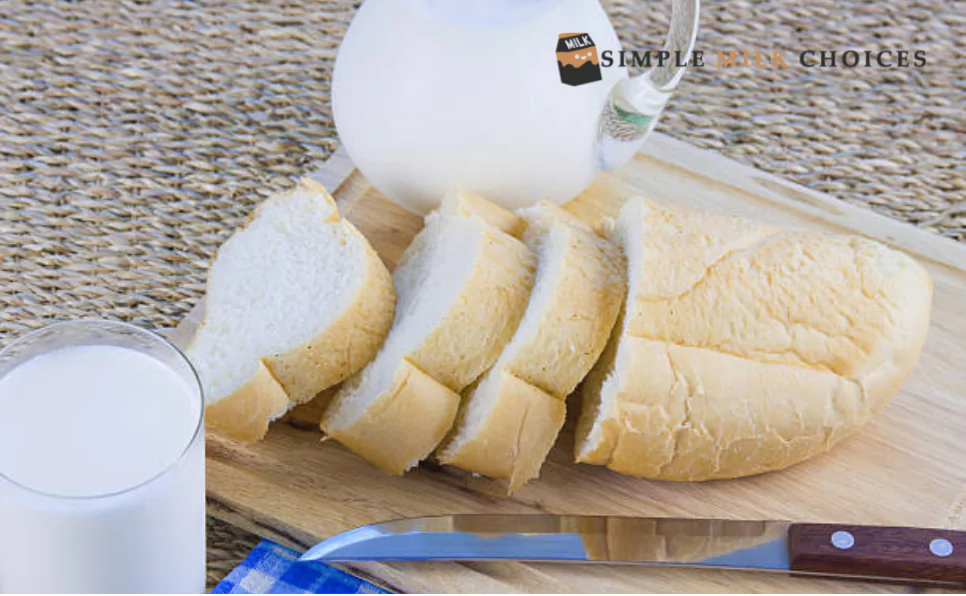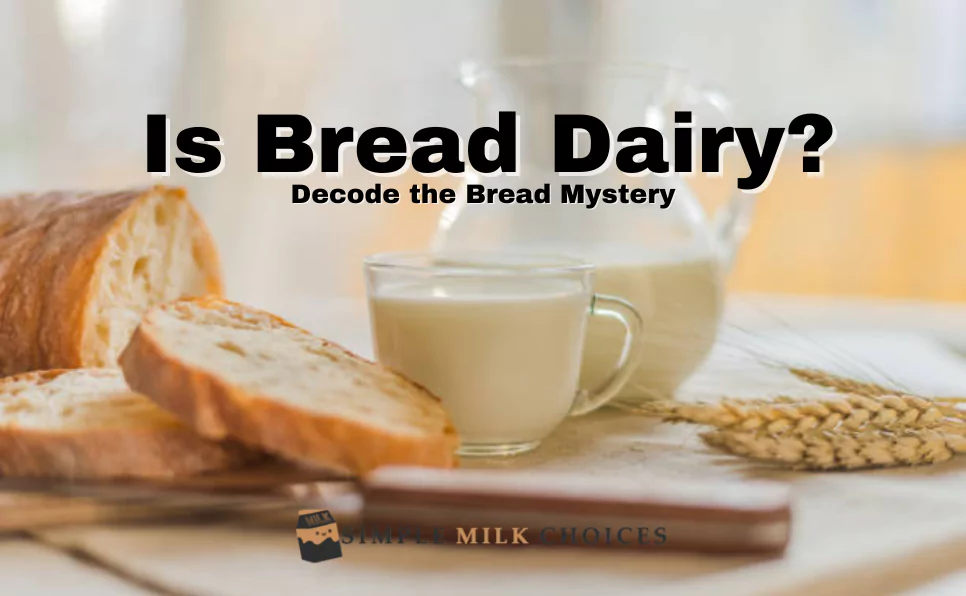The connection between bread and dairy holds huge significance in dietary contemplations. These two food classifications are dietary staples around the world, and understanding their relationship permits people to make informed decisions regarding their utilization.
Bread and dairy items are vital pieces of many weight-control plans internationally. Confusion often happens about whether bread is part of dairy. This confusion stems from the historical use of dairy in some bread recipes and the dietary restrictions people have. In this comprehensive article, we will look into whether bread contains dairy or not.
Defining Dairy and Bread
To comprehend the connection between bread and dairy, defining the two terms is crucial. Dairy refers to a range of items made from milk, like cheddar, yogurt, spread, and milk itself. Bread, then again, is produced using flour, water, yeast, and, at times, sugar, salt, or oil, without considering dairy items.
Relationship between Dairy and Bread
While bread itself doesn’t generally contain dairy, a few conventional recipes or varieties could incorporate dairy ingredients like milk, margarine, or cheddar. However, the essential parts of bread—flour, water, and yeast—structure the foundation of most bread recipes, making numerous assortments normally sans dairy. In a similar vein, individuals often ponder, Do bagels have dairy?, as certain bagel recipes may indeed include dairy ingredients like milk or butter, leading to variations in their dairy content.
Potential Dairy Inclusion in Bread
Dairy ingredients are typically used in some bread recipes for a variety of reasons. Milk may be utilized to relax the batter, while spread contributes richness and flavor. However, in contemporary times, many bread varieties offer non-dairy choices to accommodate different dietary inclinations or limitations.
Related Article: Does Mayo Contain Dairy?
Impact of Dairy in Bread on Health and Dietary Restrictions
Health Implications
Healthful Substance: Dairy-infused bread can add fundamental supplements like calcium, protein, and nutrients present in dairy items, enhancing the wholesome profile of the bread.
Sensitivities and Bigotries: For people with lactose narrow-mindedness or dairy sensitivities, consuming bread with dairy parts can set off unfriendly responses, prompting stomach-related issues or hypersensitive reactions.
Caloric and Fat Substance: Dairy components like spread or milk in bread can build their caloric and fat substances, influencing those observing their admission for weight gain or specific health reasons.
Dietary Restrictions
Veggie Lovers and Plant-Based Diets: Dairy-comprehensive bread doesn’t line up with vegetarian or plant-based dietary standards. It presents impediments for people sticking to these ways of life because of its creature-determined parts.
Lactose-Free Diets: Bread containing dairy ingredients probably won’t suit people following sans-lactose because it consumes fewer calories, requiring a shift towards dairy-free bread choices to stay away from lactose-related side effects.
Social and Strict Limitations: A few societies or religions have dietary limitations concerning dairy utilization, influencing food decisions, and requiring the determination of bread that meets these dietary rules.
Understanding the possible consideration of dairy in bread becomes essential for people with dietary limitations or sensitivities. While dairy can provide essential supplements like calcium and protein, it can likewise present health worries for lactose-intolerant people or those staying away from dairy because of health, moral, or ecological reasons.
Labeling and Recognizing Dairy in Bread
To learn whether bread contains dairy, careful reading of the ingredients becomes essential. Some bread items could contain dairy-based ingredients that are not distinctly marked, requiring attention to elective names or derivatives of dairy items in ingredient records.

Bread and Dairy Relationships in Different Cuisines
The relationship of dairy in bread differs across societies and cooking styles. A few societies vigorously incorporate dairy into their bread recipes, while others favor non-dairy choices. This variety takes special care of the exceptional dietary necessities of various populations, including those sticking to vegetarian or lactose-free diets.
Tips for Choosing Bread in a Dairy-Free Diet
Choosing bread in a dairy-free diet involves careful consideration of ingredients and label reading. Here are some tips to help with this:
Read Labels Carefully
Check for dairy ingredients: Search for clear dairy items like milk, margarine, cheddar, whey, casein, or any subordinates in the fixing list.
Be careful with hidden dairy: Some of the time, dairy is concealed under less conspicuous names like lactose, caseinate, or ghee. Be cautious while filtering marks.
Select Guaranteed Dairy-Free
Search for confirmations: Look for bread items guaranteed to be without dairy by perceived associations. This guarantees they fulfill severe without dairy guidelines.
Investigate Elective Kinds of Bread
Go for normally dairy-free varieties: Many bread types, like sourdough, entire grain, or high-quality bread, frequently don’t contain dairy. Decide on these assortments to keep away from dairy concerns.
Specialty Bread Shops or Brands
Explore dairy-free brands: A few bread kitchens or brands have some expertise in dairy-free items. Check neighborhood pastry kitchens or specialty stores offering specifically non-dairy bread choices.
Do-it-Yourself Bread Making
Prepare Your Own: Consider baking custom-made bread without dairy recipes. Along these lines, you have unlimited authority over the ingredients, ensuring they line up with your dietary necessities.
Check Cross-Contamination
Be aware of cross-defecation: In shared facilities, there may be a risk of cross-contact with dairy-containing items. Ensure that the bread is made in a non-dairy climate if you have serious sensitivities.
Ask for Ingredient List
When in Doubt, Inquire: If you’re unsure about bread’s ingredients, feel free to go to the bakery or maker for an explanation about the dairy content.
Experiment and Explore
Attempt Various Assortments: Investigate various kinds of bread to track down those that suit your taste and dietary inclinations without containing dairy.
Historical Context of Dairy in Bread
Exploring how bread is made reveals interesting insights about using dairy. Many ancient bread recipes from different cultures used dairy for different reasons. In some societies, butter or milk improved the texture and taste of traditional bread recipes.
Understanding the verifiable growth of bread and dairy mixes offers a more profound cognizance of culinary traditions and how they’ve molded dietary practices all over the planet.
Nutritional Aspects: Dairy vs. Dairy-Free Bread
Looking into the nourishing parts of bread with and without dairy parts gives a complete comprehension of their differences. Dairy-comprehensive bread might offer added supplements like calcium and protein, while non-dairy choices take special care of those looking for options, frequently with an emphasis on non-allergen or plant-based ingredients.

Allergies and Intolerances: Managing Dairy in Bread Consumption
Investigating bread options becomes a major challenge for those with bigotry or dairy sensitivities. Investigating if bread contains hidden dairy ingredients or touches dairy during production reveals potential risks. This insight helps avoid allergens effectively. For individuals with lactose intolerance or dairy allergies, avoiding bread containing dairy is crucial. Carefully checking labels and trying homemade recipes help manage dietary restrictions. Also, being cautious about cross-contamination in dining places is important.
Providing information about managing allergies related to bread helps people maintain a safe diet. Understanding sensitivities in bread usage improves health-conscious eating habits.
Evolution of Dairy-Free Bread Alternatives
The advancement of dietary inclinations and mindful eating has encouraged the improvement of a wide array of non-dairy bread choices. These choices incorporate different ingredients, for example, plant-based milk, oils, and elective alternative sources of fat and protein, taking care of assorted dietary requirements.
Exploring the growth of non-dairy bread shows how culinary practices change with diets. The evolving nature of food preferences drives these advancements.
Practical Applications: Recipes and Recommendations
Pragmatic applications without dairy bread include exploring recipes customized to prohibit dairy fixings. Selecting plant-based other options, actually looking at names, and putting resources into quality baking devices works with effective sans-dairy bread production at home. You can explore various bakeries or specialty shops that provide dairy-free options. This allows you to enjoy a wide range of breads that meet specific dietary needs.
Practical Tips for Making Dairy-Free Bread at Home
For people who lean toward handmade choices, offering viable tips and recipes for baking without dairy bread at home enables them to assume command over their dietary decisions. Investigating fixing replacements, planning strategies, and baking tips ensures effective results in the kitchen.
Choose Dairy-Free Ingredients
Begin with dairy-free substitutes like almond milk, coconut milk, or water rather than dairy-based fluids like standard milk.
Use Dairy-Free Fats
Decide on plant-based oils (like olive oil, coconut oil, or vegetable oil) rather than margarine or ghee to add dampness and wealth.
Check Your Yeast
Ensure the yeast you’re utilizing is free from dairy subordinates. Most yeast is normally without dairy, but it’s in every case great to double-check.
Read Labels Cautiously
Some bread enhancers or improvers could contain dairy subsidiaries. Continuously review the names of flour and different added substances for buried dairy.
Experiment with Flours
Investigate options in contrast to conventional wheat flour, for example, almond flour, oat flour, or gluten mixes, to make novel surfaces and flavors.
Add Regular Flavors
Upgrade your bread’s taste with spices, flavors, seeds, or dried natural products to give it a delightful lift without dairy.
Knead and Rise Appropriately
Permit the mixture to rise sufficiently for the right surface and volume. Legitimate manipulation guarantees appropriate gluten improvement for a decent design.
Adjust Liquid and Floor Ratio
Contingent upon the sort of flour utilized, you could have to change the fluid substance somewhat to achieve the ideal consistency.
Follow a Decent Recipe
Find tried-and-true dairy-free bread recipes on the web or in particular cookbooks to direct your baking cycle.
Temperature Matters
Focus on baking temperatures and times. Dairy-free bread could heat in an unexpected way, so screen it intently while in the broiler.
Giving direction on natively constructed choices energizes trial and error and culinary investigation.
Keep in mind that careful discipline brings about promising results! If your most memorable project has a few minor flaws, don’t let that deter you; it’s all important for the growing experience. Changes can continuously be made to suit your taste and dietary inclinations.
Addressing Common Misconceptions About Bread and Dairy
Clearing up misunderstandings regarding the connection between bread and dairy products helps to dispel myths and uncertainties about this subject. Tending to common misguided results, for example, accepting that all bread contains dairy or the other way around, cultivates exact comprehension and informed direction. Following are the most common misconceptions:
All Bread Contains Dairy
In contrast to popular opinion, not a wide range of bread contains dairy. While a few customary recipes incorporate dairy items like milk or spread, many bread assortments are dairy-free.
Accepting Bread as Generally Dairy-Free
While specific bread types may not clearly contain apparent dairy ingredients, it’s fundamental to read labels cautiously. Some bread varieties could, in any case, contain stowed-away dairy substitutes in added substances or flavorings.
Dairy in Bread Equivalents Lactose
Individuals frequently associate dairy with lactose. However, dairy in bread could not be ensured to mean lactose; it could incorporate butterfat or other dairy-determined parts that don’t contain lactose.
Glutten Free Means Dairy-Free
A typical misinterpretation is expecting that sans-gluten bread is naturally without dairy. While some without gluten choices could likewise be sans dairy, it’s anything but a general rule. Continuously look at names for explicit dietary necessities.
Expecting All Without Dairy Bread is Better
While without dairy bread, it could take special care of lactose-intolerant or veggie-loving people, it doesn’t necessarily mean better. Some non-dairy bread assortments could contain added sugars, additives, or different added substances.
Sans-Dairy Bread Needs Flavor
Some accept that killing dairy compromises the flavor of bread. However, numerous non-dairy bread recipes utilize elective fixings and flavorings to improve taste and surface.
It is Clear to Expect Sensitivities
Many expect that, assuming bread contains dairy, it will be expressly named because of sensitivity concerns. Tragically, this isn’t generally the situation, as certain subordinates probably won’t be plainly expressed on bundling.
Misconstruing Dairy Options
Subbing dairy with plant-based options in bread recipes could not necessarily, in every case, yield comparative outcomes. The taste and surface can vary, requiring changes and trial and error.
Explaining misguided results adds to a more educated consumer base.
Conclusion: Embracing Bread's Diversity
In conclusion, whether or not bread is intrinsically dairy depends on different variables, including conventional recipes, marking practices, and individual dietary prerequisites. While specific bread varieties generally incorporate dairy, not all breads contain dairy ingredients. Understanding this qualification enables people to settle on informed decisions, whether taking care of explicit dietary requirements, sensitivities, or way of life inclinations. By perusing names mindfully and investigating options, one can partake in a different scope of bread choices, ensuring that their decisions line up with their dietary contemplations. At last, perceiving the nuanced connection between bread and dairy takes into consideration a more cognizant and fitting way to deal with one’s culinary determinations.





